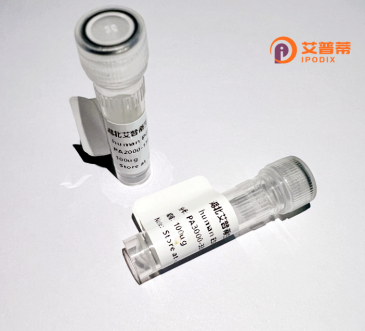
| 纯度 | >90%SDS-PAGE. |
| 种属 | Human |
| 靶点 | HFE2 |
| Uniprot No | Q6ZVN8 |
| 内毒素 | < 0.01EU/μg |
| 表达宿主 | E.coli |
| 表达区间 | 36-400aa |
| 氨基酸序列 | QCKIL RCNAEYVSST LSLRGGGSSG ALRGGGGGGR GGGVGSGGLC RALRSYALCT RRTARTCRGD LAFHSAVHGI EDLMIQHNCS RQGPTAPPPP RGPALPGAGS GLPAPDPCDY EGRFSRLHGR PPGFLHCASF GDPHVRSFHH HFHTCRVQGA WPLLDNDFLF VQATSSPMAL GANATATRKL TIIFKNMQEC IDQKVYQAEV DNLPVAFEDG SINGGDRPGG SSLSIQTANP GNHVEIQAAY IGTTIIIRQT AGQLSFSIKV AEDVAMAFSA EQDLQLCVGG CPPSQRLSRS ERNRRGAITI DTARRLCKEG LPVEDAYFHS CVFDVLISGD PNFTVAAQAA LEDARAFLPD LEKLHLFPSD |
| 分子量 | 45.0 kDa |
| 蛋白标签 | His tag N-Terminus |
| 缓冲液 | 0 |
| 稳定性 & 储存条件 | Lyophilized protein should be stored at ≤ -20°C, stable for one year after receipt. Reconstituted protein solution can be stored at 2-8°C for 2-7 days. Aliquots of reconstituted samples are stable at ≤ -20°C for 3 months. |
| 复溶 | Always centrifuge tubes before opening.Do not mix by vortex or pipetting. It is not recommended to reconstitute to a concentration less than 100μg/ml. Dissolve the lyophilized protein in distilled water. Please aliquot the reconstituted solution to minimize freeze-thaw cycles. |
以下是3条关于重组人HFE2蛋白(Hemojuvelin)的参考文献及其摘要概括:
---
1. **文献名称**:*Mutagenesis of the Hemojuvelin reveals functionally important sites for its role in BMP signaling*
**作者**:Jodie L. Babitt et al.
**摘要**:研究通过定点突变分析重组人HFE2蛋白的结构-功能关系,揭示了其关键区域(如RGM结构域)在调控BMP信号通路及铁调素(hepcidin)表达中的作用,证实HFE2通过BMP受体复合物参与铁代谢调节。
---
2. **文献名称**:*Recombinant Hemojuvelin rescues iron overload in Hfe2 knockout mice*
**作者**:Nancy C. Andrews et al.
**摘要**:通过重组HFE2蛋白在Hfe2基因敲除小鼠中恢复铁调素表达,逆转铁过载表型,证明重组HFE2可潜在用于遗传性血色素沉着症(Type 2A)的治疗。
---
3. **文献名称**:*Expression and purification of functional human Hemojuvelin in mammalian cell systems*
**作者**:Antonello Pietrangelo et al.
**摘要**:描述利用哺乳动物细胞系(如HEK293)高效表达和纯化重组人HFE2蛋白,验证其糖基化修饰对蛋白稳定性和BMP信号活性的必要性。
---
以上文献均聚焦于HFE2蛋白的重组制备、功能机制及其在铁代谢疾病中的应用。
Hemojuvelin (HFE2), encoded by the *HFE2* gene, is a key regulator of iron homeostasis, primarily through its role in modulating hepcidin expression. Hepcidin, a liver-derived hormone, controls systemic iron levels by inhibiting intestinal iron absorption and macrophage iron release. Mutations in *HFE2* are linked to juvenile hemochromatosis, a severe iron-overload disorder characterized by early-onset organ damage due to excessive iron accumulation.
Recombinant human HFE2 protein (rhHFE2) is produced using biotechnological systems such as mammalian cell cultures or *E. coli*, enabling large-scale synthesis for research and therapeutic applications. As a glycosylphosphatidylinositol (GPI)-anchored membrane protein, HFE2 also exists in soluble forms generated via proteolytic cleavage or alternative splicing. Recombinant forms often mimic these soluble variants, retaining bioactivity to interact with bone morphogenetic proteins (BMPs) and modulate the BMP-SMAD signaling pathway critical for hepcidin upregulation.
Studies utilizing rhHFE2 focus on elucidating iron regulation mechanisms, exploring mutation-induced functional defects, and developing therapeutic strategies for iron-related disorders. Its potential application includes supplementing defective HFE2 in genetic hemochromatosis or neutralizing excessive BMP signaling in iron-refractory conditions. Despite challenges in preserving post-translational modifications, advancements in expression systems continue to enhance rhHFE2’s functional fidelity, underscoring its value in both basic research and clinical innovation.
×